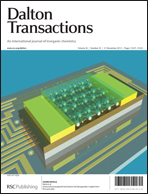A phosphorus-based compartmental ligand, (S)P[N(Me)N![[double bond, length as m-dash]](https://www.rsc.org/images/entities/char_e001.gif) CH–C6H3-2-O-3-OMe]3 (LH3), enables the assembly of luminescent heterobimetallic linear {L2Zn2Ln}+ [Ln = Gd, Tb, Nd and Eu] complexes†
CH–C6H3-2-O-3-OMe]3 (LH3), enables the assembly of luminescent heterobimetallic linear {L2Zn2Ln}+ [Ln = Gd, Tb, Nd and Eu] complexes†
Abstract
The sequential reaction of a phosphorus-based trishydrazone ligand, LH3 with anhydrous ZnCl2 and LnCl3·6H2O in a 2 : 2 : 1 stoichiometric ratio in the presence of triethylamine as the base leads to the formation of monocationic trinuclear complexes [L2Zn2Ln]Cl {Ln = Gd (1), Tb (2), Nd (3), Eu (4) and L = [(S)P[N(Me)N![[double bond, length as m-dash]](https://www.rsc.org/images/entities/char_e001.gif) CH–C6H3-2-O-3-OMe]3}. All the three metal ions, in each of these compounds, are arranged in a linear fashion. The two terminal Zn(II) ions are encapsulated by three imino and three phenolate oxygen atoms while the lanthanide ion remains in the centre with an all-oxygen coordination environment. Detailed photophysical measurements reveal the complete absence of antenna sensitization in all the four complexes. However, a strong emission was found for 2 and 4 when excited directly at their f–f levels.
CH–C6H3-2-O-3-OMe]3}. All the three metal ions, in each of these compounds, are arranged in a linear fashion. The two terminal Zn(II) ions are encapsulated by three imino and three phenolate oxygen atoms while the lanthanide ion remains in the centre with an all-oxygen coordination environment. Detailed photophysical measurements reveal the complete absence of antenna sensitization in all the four complexes. However, a strong emission was found for 2 and 4 when excited directly at their f–f levels.
![Graphical abstract: A phosphorus-based compartmental ligand, (S)P[N(Me)N [[double bond, length as m-dash]] CH–C6H3-2-O-3-OMe]3 (LH3), enables the assembly of luminescent heterobimetallic linear {L2Zn2Ln}+ [Ln = Gd, Tb, Nd and Eu] complexes](/en/Image/Get?imageInfo.ImageType=GA&imageInfo.ImageIdentifier.ManuscriptID=C3DT51431E&imageInfo.ImageIdentifier.Year=2013)

 Please wait while we load your content...
Please wait while we load your content...
![[double bond, length as m-dash]](https://www.rsc.org/images/entities/h2_char_e001.gif) CH–C6H3-2-O-3-OMe]3 (LH3), enables the assembly of luminescent heterobimetallic linear {L2Zn2Ln}+ [Ln = Gd, Tb, Nd and Eu] complexes
CH–C6H3-2-O-3-OMe]3 (LH3), enables the assembly of luminescent heterobimetallic linear {L2Zn2Ln}+ [Ln = Gd, Tb, Nd and Eu] complexes